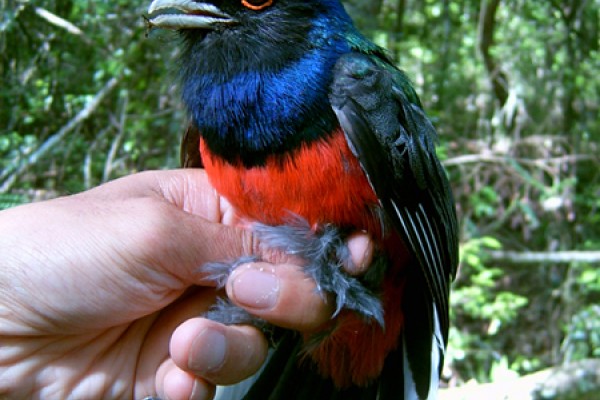 ::cck::161::/cck::
::cck::161::/cck::
::introtext::
This project is in its final phase. The data were collected in the field, analyzed and are now being prepared for publication. The study was divided into five chapters. The first is a general analysis of fragmentation on the birds of the study region.
::/introtext::
::fulltext::
The project Threatened Birds adopts two fronts:
1 – This project is in its final phase. The data were collected in the field, analyzed and are now being prepared for publication. The study was divided into five chapters. The first is a general analysis of fragmentation on the birds of the study region.
We evaluated the response of bird species, functional groups and communities to forest fragmentation. Landscape parameters selected as explanatory variables were: size and degree of isolation of fragments and vegetation structure. These variables are those likely most relevant to determining abundance and distribution of species in the Pontal do Paranapanema.
The second phase addresses the use of agro-forestry lots by birds and the possibility that these function as stepping-stones between fragments. The study also includes data from a Master’s degree (Beyer, 2006) focusing on the presence and abundance of bird species in the lots and other connectivity elements. This chapter defines the relative importance of different landscape elements for distinct birds groups and proposes a general hypothesis for the effective use of ecological stepping stones. The results of these studies were published in: Uezu, A., Beyer, D.D, Metzger, J.P., 2008. Can agro-forest woodlots work as stepping stones for birds in the Atlantic forest region? Biodiversity and Conservation. http://www.springerlink.com/content/g71857p74131r124/
The third chapter addresses the effect historical landscape structure in the Pontal do Paranapanema on the richness of different bird functional groups and suggests there exists latency between fragmentation and the response of the groups most sensitive.
The fourth chapter deepens the discussion on this latency time. The number of species each fragment would lose and the latency time for this to occur were estimated based on the relation between species and area. The results show that many species have already been lost in the study fragments and that others may become extinct locally in the medium term (approximately 30 years), highlighting the importance of landscape management in avoiding these loses.
The fifth chapter compares the effect of fragmentation on the bird fauna in three landscapes of two distinct regions: one in western São Paulo State (Pontal do Paranapanema) and the other in the east of the State (Caucaia do Alto and Ibiúna). The data on birds in the latter region were obtained from previous Ph.D. research (Develey, 2004), where the data collection was similar to that adopted in the current study. Despite significant differences between these two regions, 57 species co-occur in both. The geographic location, degree of isolation, size of fragments and distance to source areas are essential factors that determine the response of species to fragmentation. This project was part of a Ph.D. thesis supervised by Professor Jean Paul W. Metzger, of the Biosciences Institute/USP and is available at:http://www.teses.usp.br/teses/disponiveis/41/41134/tde-14082007-120424//. This work has been partly supported, both logistically and technically, by IPÊ researchers and staff (e.g. data access, internships and third party services such as field assistants).
2 – In this project, 24 landscapes will be studied along the Mantiqueira-Cantareira corridor. These will consist of quadrant (3 km x 3 km; Fig.1) that vary in proportion of habitat and forest coverage, which will range from 100% within continuous areas of the Serra da Cantareira and Mantiqueira ranges to landscapes with less than 10% forest cover. In addition to these variables, we will select landscapes composed of varying impacts from human use, such as reforestation, pasture and agriculture. In each sampling unit, data on spatial structure and bird species will be collected. We will employ various methods, including: call-back surveys, which allows for estimates of relative species abundance and community and functional group richness, mist net capture and ringing, analysis of biological samples (blood, feces and ectoparasites) and radio telemetry.
::/fulltext::
::ac_acordeon::3::/ac_acordeon::
::cck_ac_acordeon::acordeon::/cck_ac_acordeon::
::ac_titulo_acordeon|0|ac_acordeon::Objectives::/ac_titulo_acordeon|0|ac_acordeon::
::ac_texto_acordeon|0|ac_acordeon::
Project 1
- Study the effects of fragmentation on bird communities in the Atlantic Forest of the Pontal do Paranapanema, with emphasis on questions of fragmentation history, species sensitivity, connectivity through stepping stones and loss of genetic variability.
Project 2
- Evaluate how species diversity is distributed throughout the region;
- Identify the species and/or groups of species most threatened in the region and the landscape factors that most affect them;
- Analyze the parameters of spatial landscape structure (e.g. proportion of forest cover, fragment size, connectivity, distance and source forests) that are most relevant to determining the presence and abundance of species;
- Verify if there exists a threshold of habitat proportion that leads to a sudden drop in bird diversity;
- Survey habitat use and the dispersal patterns of two bird species in the study region, with consideration of landscape composition and spatial structure;
- Quantify the dispersal cost for these two species in different elements of the landscape;
- Create models of habitat use and connectivity;
- Evaluate the health status of bird species and verify how landscape parameters affect health;
- Identify the diseases whose dispersal is favored in fragmented landscapes;
- Extrapolate the data generated in the 24 landscapes chosen to the entire gradient between the Mantiqueira and Cantareira mountain ranges in order to propose management actions to benefit the region.
::/ac_texto_acordeon|0|ac_acordeon::
::cckend_ac_acordeon::::/cckend_ac_acordeon::
::cck_ac_acordeon::acordeon::/cck_ac_acordeon::
::ac_titulo_acordeon|1|ac_acordeon::Team::/ac_titulo_acordeon|1|ac_acordeon::
::ac_texto_acordeon|1|ac_acordeon::
Alexandre Uezu Coordenador Contato: aleuezu@ipe.org.br
Maria H. Ogrzewalska Bióloga Contato: mogrzewalska@yahoo.com
::/ac_texto_acordeon|1|ac_acordeon::
::cckend_ac_acordeon::::/cckend_ac_acordeon::
::cck_ac_acordeon::acordeon::/cck_ac_acordeon::
::ac_titulo_acordeon|2|ac_acordeon::Support::/ac_titulo_acordeon|2|ac_acordeon::
::ac_texto_acordeon|2|ac_acordeon::
Project 1
- Fapesp
- Idea Wild
- The E. Alexander Bergstrom Memorial Research Award- Association of Field Ornithologists.
::/ac_texto_acordeon|2|ac_acordeon::
::cckend_ac_acordeon::::/cckend_ac_acordeon::
::ac_arquivos::1::/ac_arquivos::
::cck_ac_arquivos::arquivo::/cck_ac_arquivos::
::ac_titulo_arquivo|0|ac_arquivos::::/ac_titulo_arquivo|0|ac_arquivos::
::ac_arquivo|0|ac_arquivos::::/ac_arquivo|0|ac_arquivos::
::cckend_ac_arquivos::::/cckend_ac_arquivos::
::ac_galeria::3::/ac_galeria::
::cck_ac_galeria::galeria::/cck_ac_galeria::
::ac_foto_descricao|0|ac_galeria::::/ac_foto_descricao|0|ac_galeria::
::ac_foto|0|ac_galeria::images/artigo_completo/galeria/1278/130-ebc4525543.jpg::/ac_foto|0|ac_galeria::
::cckend_ac_galeria::::/cckend_ac_galeria::
::cck_ac_galeria::galeria::/cck_ac_galeria::
::ac_foto_descricao|1|ac_galeria::::/ac_foto_descricao|1|ac_galeria::
::ac_foto|1|ac_galeria::images/artigo_completo/galeria/1278/230-d92591c3a1.jpg::/ac_foto|1|ac_galeria::
::cckend_ac_galeria::::/cckend_ac_galeria::
::cck_ac_galeria::galeria::/cck_ac_galeria::
::ac_foto_descricao|2|ac_galeria::::/ac_foto_descricao|2|ac_galeria::
::ac_foto|2|ac_galeria::images/artigo_completo/galeria/1278/327-c0aa9e9727.jpg::/ac_foto|2|ac_galeria::
::cckend_ac_galeria::::/cckend_ac_galeria::


